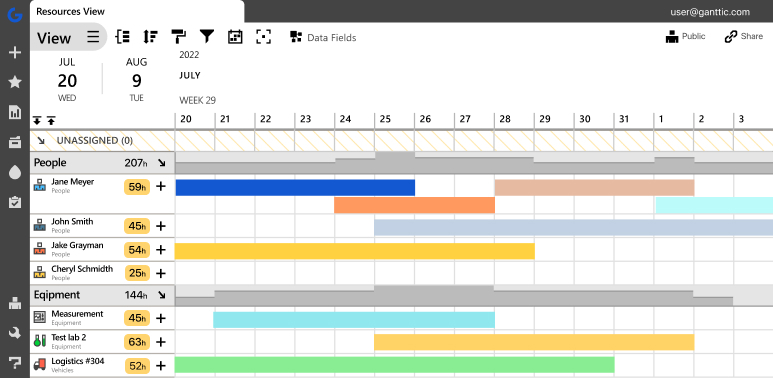Keeping up with ever-changing goals and managing a team while handling multiple projects can be chaotic for a project manager.
A project manager is responsible for several due dates, task owners, team meetings, and 1:1 presentations to clients. Despite all this, a few project bottlenecks or deadline changes add to further complications.
Even the most skilled project manager needs a way to systemize and track their accomplishments. However, most PMs would define their success by the number of projects delivered on time without exceeding their budget.
Research shows that only 15% of project managers focus on a single project at one time. Most PMs manage around five projects, and the number can go as high as 10. But how do project managers keep track of all this?
By setting up a process for project pipeline management. In this article, we cover all the aspects you need to know for the same.
What is Project Pipeline Management?
Project pipeline management refers to the standardized steps, or the framework project managers use to track multiple projects. From ideation to selecting a project and its launch, project pipeline management ensures every task has proper timelines, sufficient resources allocated, and workflows mapped out in detail for efficiency.
The critical stages of Project Pipeline Management include:
1. Ideation
In this stage, new project ideas are generated. It involves gathering ideas from the team, developing many project proposals, and creating an atmosphere where the employees are encouraged to share their ideas for new initiatives openly.
2. Work Intake
This stage involves creating proposals for the prioritized project ideas and getting them approved by the upper management. The proposal must outline the project scope, expected outcome, and timeline.
3. Phase-Gates
This step averts projects that may fail from entering the pipeline while filtering out the critical strategic initiatives that benefit the organization.
Why is project pipeline management important?
Research shows that there is a limit to what people can take on. And at any given time, 2-3 projects is about the ideal number that an individual should be expected to juggle. But for a project manager, it’s likely that you’ll have anywhere from 3 to 20+ projects happening simultaneously. This means taking the time to organize a project pipeline is more than a “best practice.” It’s a necessity! Here’s a few more benefits to this technique.
- A project pipeline gives you a clear overview of all the stages of your projects. The project goals help further advance company goals and values.
- Tracking the progress of your project is crucial. Observing each project move from stage to stage allows you to manage multiple projects simultaneously.
- Resource capacity planning and resource allocation go hand-in-hand with your project pipeline.
- Record-keeping remains up-to-date. Managing your pipelines means you stay on top of your documentation.
- It assists you in being mindful of the agreed project metrics, success factors, dates, budgets, time tracking with invoicing, timesheets, and learning points.
7 tips for managing project pipeline effectively
1. Make sure that you have enough resources
An essential stage before initiating any project is ensuring you have sufficient resources to complete the tasks on time. Assess the resource pool of your workplace by getting a synopsis of the establishment’s available resource capacity, skillset, and charge-out rates that are essential to reach each project milestone.
Resource planning and personnel allocation are supervised by resource managers, who work together with project managers. They evaluate an organization’s capacity to fulfill project staffing requirements, assign individuals to tasks, acquire new employees, and plan future projects precisely. At this point, making use of a resource planning tool can help balance demand with real-time availability.
Read on: What are the benefits of capacity allocation? Not only are you more likely to deliver your projects on time and on budget, but you’re drastically reducing the chance of unexpected problems occurring. See what else you can accomplish with a resource capacity planner on your side.
Adopting the latest methodologies and implementing innovative technologies and tools has become an essential priority to boost your standing in the current business scenario. Hence, having the best project management solutions are tools necessary to improve your game.
These tools come in handy when the team members have to quantify, objectify, segregate and delegate tasks appropriately and proportionately. It is software designed to assist project teams in planning, tracking, and managing the projects to accomplish the defined project goals within the stipulated time frame.
A Gantt chart is one of the top project management tools as it comprehensively represents the work breakdown structure. A Gantt chart visualizes the project timeline, keeps track of the project schedule, checks for any deviations from the project plan, and detects delays.
3. Be transparent and maintain communication with stakeholders

One of the most invaluable skills in managing a successful organization or project is being able to set up effective and clear communication within the team as well as with all stakeholders involved.
Stakeholders are the internal and external people that take an interest in your business and are vital as they provide your project and organization with support and input both from a business and a financial perspective.
Remember your stakeholders, as they are a constant in your pipeline. Practice utmost transparency by regularly appraising the stakeholder’s timeline, milestones, and budget. Keep them updated about project progress at every stage to ensure the team works in the correct direction.
Take feedback from the client, apprise the project managers, and act proactively. You must consult them and verify if the projects meet their objectives and needs. If your client wants multiple modifications to their requirements, clarify the extra costs they incur.
This clarity of costs is particularly important to maintain from the very beginning, and is part of communicating effectively when working with third parties. So using specific tools to take care of this will make your life easier. Software like the Joist plumbing estimating app is an example of why industry-focused platforms are worth adopting in this context.
4. Monitor the progress of the project
Monitoring project progress involves tracking many features, as most projects involve multiple team members managing various aspects of the project simultaneously.
As a PM, you need a bird’s eye view of the budget, schedule, resources, scope, and tasks to be completed. To ensure the success of a project, effective monitoring helps maintain your timeline and identify glitches early on in the process.
Ensure that you have pipeline report examples to show the investors or high-level stakeholders and not just reports about individual projects or tasks of a project. And most importantly, remember your agreed KPI or metrics. These metrics will be beneficial in evaluating, retrospection, and trouble spotting for adjustments during the progress stage.
5. Create a sound financial roadmap to ensure profitability
A considerable revenue after the completion of a project is crucial to get a significant Return on Investment (ROI). It is a well-known fact that when a project is profitable, it improves the firm’s topline.
Determining the potential profitability of a proposed project is very vital. Analyzing profitability is how businesses decide whether or not a project is worth the time, effort, and resources allocated toward that project. This is also how companies decide which project to prioritize when multiple projects are contending for resources within an organization.
Create a sound financial roadmap to make sure your project is profitable. Forecasting and capacity planning tools can easily choose the perfect resources to increase profit margins. While working on the financial roadmap, selecting the best analysis tools to generate excellent outcomes lowers the resourcing costs and increases precision in financial planning.
6. Review and improve your sales process periodically
A successful and productive pipeline relies on an effective sales process. Project managers must create a well-defined sales process as the sales and delivery are complex. A pipeline involves multiple projects at different stages. The sales team has to sync with the project execution team to help keep track of these projects.
While developing the sales process, be mindful of maintaining the sales workflow and collaborating with the delivery team regularly to help meet the client’s requirements. Keeping track and periodically reviewing projects and generating leads helps improve sales.
7. Automate wherever you can
Create systems in your business plan that happen on their own through automation. By doing this, you are eliminating tedious tasks that consume too much of your time. So, go ahead and automate, save time, reduce stress, and have happier clients.
Integrate monotonous tasks like invoicing and time tracking into your project pipeline. Time sheeting benefits you in tracking the time taken by each assigned employee on specific projects. You can also try automating your work processes with CRM software like Salesforce, HubSpot, Zoho, Bitrix24, and Firmao. Cloud-based software like Firmao provides a unique ability to quickly and easily adapt to the specific needs of any company. Plus, Firmao can be easily integrated with more than 1,000 external IT systems.
Getting precise reports about the time distribution can be used for automating invoice processing if you want to invoice your project based on timesheets. Incorporating such functions in your project management tool helps you track the money trail across your entire pipeline.
Conclusion

To succeed in your projects, perfect project management and resource management tools must be implemented to document and assess real-time project progress.
A single integrated tool helps get a consolidated view of the project metrics. An accurate approach improves project estimations and allows PMs to make data-driven decisions. They must regularly contact the sales team to update clients’ expectations. A systematic approach helps improve project and resource plans, enabling the managers to make decisions based on real-time insights and uphold project estimation.